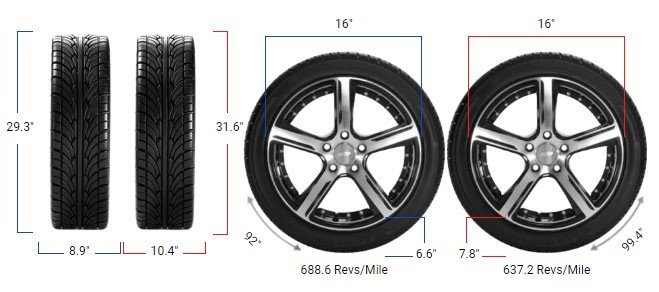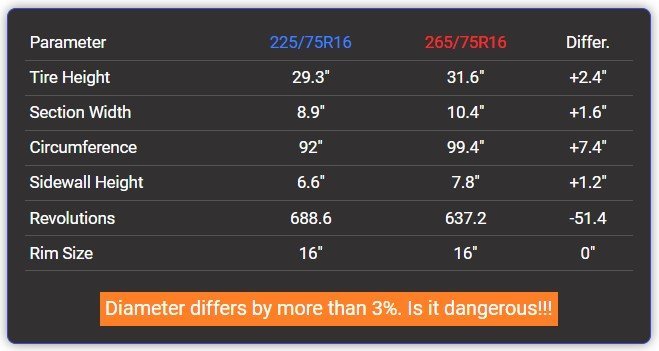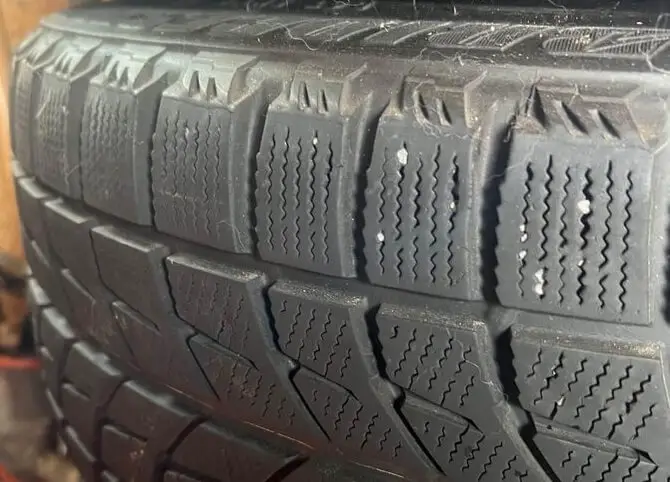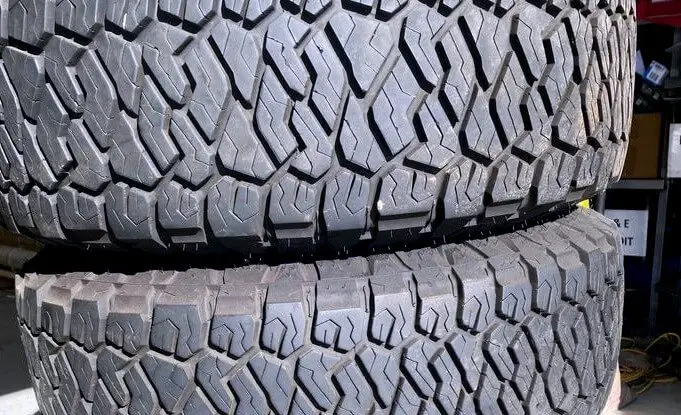Tire Size 225/75r16 vs 265/75r16

Ever wondered about beefing up your ride with bigger tires? Buckle up as we explore the thrilling world of tire upsizing, comparing the popular 225/75r16 and 265/75r16 options!
- Increased sidewall height offers better cushioning and a smoother ride
- Wider tires may negatively impact fuel economy due to increased rolling resistance
- Larger tire size can enhance vehicle appearance with a more aggressive stance
- Improved ground clearance benefits off-road capability and obstacle clearance
- Potential rubbing or clearance issues may arise due to larger tire size
225/75r16 vs 265/75r16 Table
By referring to this table, you can easily comprehend the dissimilarities between tire size.

Fitment Guide
The difference between 225/75r16 and 265/75r16 tires is 8.1%, far exceeding the recommended 3% limit.
This significant size increase means the interchange is not recommended without making necessary adaptations to your vehicle.
On-Road Impact
Switching to larger tires can dramatically alter your vehicle’s on-road behavior. Let’s examine how this tire upgrade might affect your daily drive:
- Speedometer Accuracy: With the 8.1% increase in diameter, your speedometer will underreport your actual speed. When it reads 20 mph, you’ll actually be traveling at 21.61 mph. This discrepancy could lead to unintentional speeding.
- Fuel Efficiency: Larger, heavier tires require more energy to rotate, potentially decreasing your fuel economy. The 265/75r16 tires have a 7.5% decrease in revolutions per mile, which means your engine has to work harder to maintain the same speed.
- Acceleration and Braking: The increased rotational mass of the larger tires can result in slightly slower acceleration and longer braking distances. This effect might be noticeable during quick maneuvers or emergency stops.
- Ride Comfort: The wider 265/75r16 tires offer a larger contact patch with the road, which can improve stability. However, the taller sidewalls (7.82 inches vs 6.64 inches) might introduce more flex, potentially affecting handling precision on paved roads.
- Noise Levels: Wider tires often generate more road noise, especially if they have an aggressive tread pattern. This could make your cabin slightly louder during highway driving.

Off-Road Impact
For off-road enthusiasts, the switch to 265/75r16 tires can bring some exciting benefits:
- Ground Clearance: The 2.36-inch increase in diameter translates to about 1.18 inches of additional ground clearance. This extra height can be a game-changer when navigating rocky terrain or deep ruts.
- Traction: The wider 265/75r16 tires provide a larger contact patch with the ground, offering improved grip in loose or muddy conditions. This can enhance your vehicle’s off-road capabilities significantly.
- Obstacle Clearance: Larger tires make it easier to roll over obstacles without getting hung up. The increased diameter allows your vehicle to tackle larger rocks or logs with greater ease.
- Flotation: In soft terrains like sand or snow, the wider 265/75r16 tires distribute the vehicle’s weight over a larger area. This “flotation” effect can help prevent sinking and improve overall traction.
- Durability: The taller sidewalls of the 265/75r16 tires (7.82 inches vs 6.64 inches) provide extra protection against punctures from rocks or other sharp objects encountered off-road.

What is the Main Difference Between 225/75r16 and 265/75r16?
The main difference between 225/75R16 and 265/75R16 tires is the 8.1% increase in overall diameter and 17.8% increase in width when going up to the 265/75R16 size.
Can I Use 265/75r16 Instead of 225/75r16?
Using 265/75R16 tires instead of 225/75R16 is not recommended without vehicle modifications, as the 8.1% diameter difference exceeds the acceptable 3% range, potentially causing fitment issues.
How Much Taller Is a 265/75r16 Tire Than a 225/75r16?
A 265/75R16 tire is 2.36 inches (60 mm) taller in overall diameter and has 1.18 inch (30 mm) taller sidewalls compared to a 225/75R16 tire.
How Much Wider is a 265/75r16 Tire Than a 225/75r16?
The 265/75R16 tire size is 1.57 inches (40 mm) wider than the 225/75R16 size, providing a 17.8% increase in tire width and a larger contact patch.
Our Observations
After weighing the differences between 225/75R16 and 265/75R16 tires, we’ve found that while the size increase offers some off-road benefits, it comes with trade-offs for daily driving.
The 8.1% larger diameter and 17.8% wider footprint can moderately improve traction and durability in off-road situations.
However, for on-road use, the impact on fuel efficiency, speedometer accuracy, and ride quality may be more noticeable drawbacks.
Ultimately, the decision to switch should be based on your specific vehicle, driving habits, and intended use.

Meet Caitlin McCormack, a Tire Size Expert and Blogger Passionate About Everything Related to Tires. With Years of Experience in the Tire Industry, Caitlin Has Become an Expert in Tire Sizes and Their Impact on Vehicle Performance.
